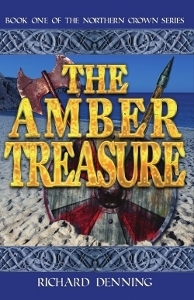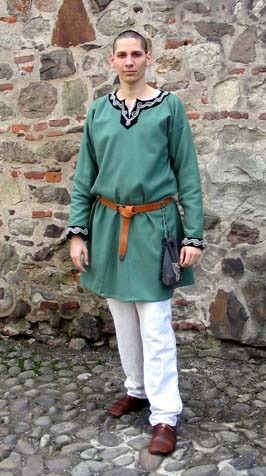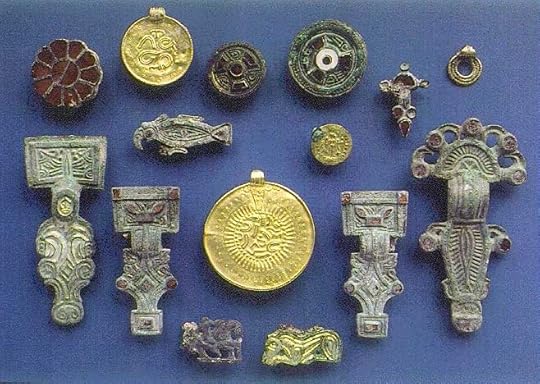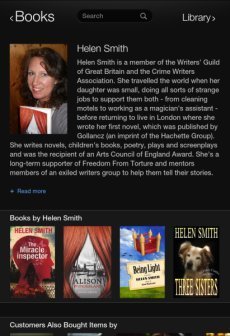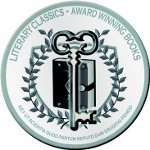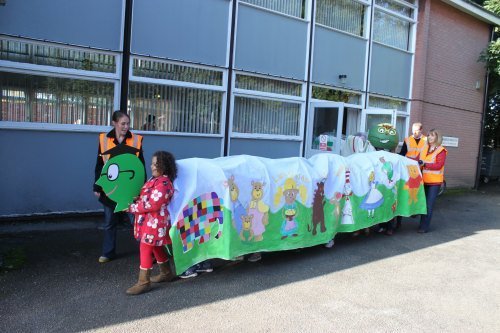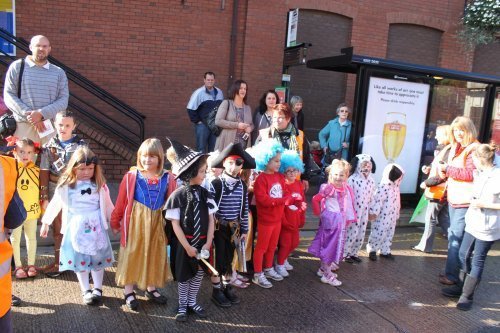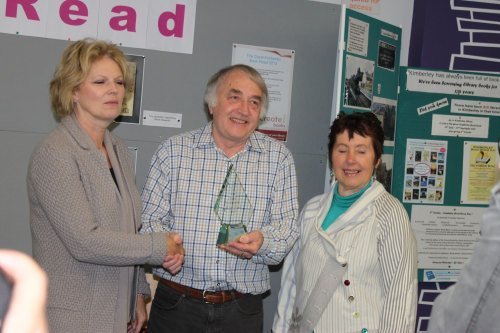Richard Denning's Blog, page 9
December 1, 2012
Evidence and guesswork in the 6th Century
Written Evidence
Evidence and guesswork in the 6th Century
I was not long born the day my uncle stood on the battlefield, surrounded by the corpses of his men.
They had died defending this narrow gully through hills which blocked the approach to the city of Eboracum. The city lay to the east under a pall of smoke that arose from a hundred burning houses. King Aelle had taken the army there to capture it but, hearing reports of an enemy warband coming to lift the siege, had sent Cynric and his company around the city to the west to intercept them.
Eighty men marched through the night to reach this sunken road. They planted their flag in the ditch so it streamed in the wind, revealing the image of the running wolf emblazoned upon it. Then, they gathered about it and waited.
They did not have to wait long… (Excerpt from The Amber Treasure)
Some of the historical fiction which I have written is set in a remote and obscure period. Writing about the late 6th and early 7th century in The Amber Treasure puts you right in the middle of the darkest years of the Dark Ages.
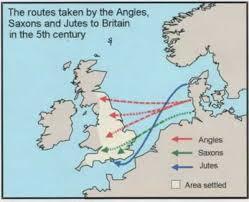
When the last Roman soldier departed Britain in about 417 AD reliable documentation of events started to collapse. The invading Anglo-Saxon tribes were effectively illiterate and it was not until the coming of Christianity (which did not fully pervade England until the late 7th century) that some form of regular record keeping returned. It really took until the time of Alfred the Great at the end of the 9th century for reliable continuous commentaries on the goings on in the land to be kept in the form of the Anglo Saxon Chronicle and other documents.
What then do we do when we want to find out what happened in the early Saxon period? Where could I turn to when writing a book set in the late 6th century?
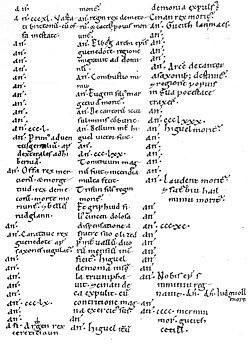
The documents that I turned to when trying to found out what historians knew about this period were:
De Excidio et Conquestu Britanniae On the Ruin and Conquest of Britain) by Gildas. Gildas was a monk who lived around AD 500 to 570 in the Dumfries area of Scotland (what was then the British Kingdom of Strathclyde). Much of what we know about the possible existence of Arthur, Vortigern, Ambrosius and so on comes from Gildas. His writing shows the state of chaos and confusion with a land split between half a dozen races and the civilization that had persisted for four centuries collapsing. There are limits to Gildas however. Firstly he had a message to pass on. He wrote about the downfall of Britain – the end of Roman rule and the invasion of the Anglo Saxons and very much argued that this was God’s punishment for their sins. More importantly he died around AD 570 – JUST before the period I was writing about.
The Historia ecclesiastica gentis Anglorum: Ecclesiastical History of the English People by Bede. Bede was a late 7th and early 8th century scholar and monk. His main work is believed to have been completed in 731. Bede writes a lot about the ancient (to him) history of Britain and basically stopped around the fall of Britain and the end of Roman rule, picking up the story with the Augustine mission in 597. He only really gets interested in the conflict between Celtic and Roman Christianity and the conversion of kings and very much argues that the defeat of the Britons is the result of them backing the wrong horse (theologically speaking). So he was quite content to report Pagan English slaughter of Welsh monks as being justified for example. All that said he has a lot of detail from the early 7th century onwards BUT there is an agonising gap before about AD 600.
The Historia Brittonum, or The History of the Britons, is a historical work that was first composed around 830 by the Welsh Monk Nennius. It contains a lot of of detail on the Arthurian period and some full genealogies of the Royal Families of Deira and Bernicia but again there is an annoying lack of commentary on the late 6th century.
Annales Cambriae, or The Annals of Wales, and other Annales in Ireland and Scotland are chronologies and lists of dates compiled in the 8th to 12th centuries in various monasteries and then combined together. They offer snippets and brief glimpses of events - particularly brief the further back you go. Names come up, some useful dates but very little detail. It its like looking at the contents page of history text book! Scholars though can study all these fragments and combine them into something approaching a coherent history and these add some knowledge.

The Anglo Saxon Chronicle (late 9th century and afterwards)
Probably started by King Alfred the Great who at least sponsored and encouraged it, this was a chronicle of events in England and surrounding lands recorded by monks. It focuses on the large events, battles, Kings and Lords and so forth and at first glance would seem to be just the thing. BUT there are limitations to its usefullness. The writers were living in a period over three hundred years after the events they recorded and so were relying on passed on word of mouth or old documents that no longer exist and we cannot validate. Moreover the Chronicle is south centric – focusing for the most part on the events in the southern kingdoms and little on those in Northumbria where my story is set. This is so much so that the chroniclers seems to just simplify matters by lumping the Royal Houses of Deira and Bernician (the two parts of Northumbria) into one. Fortunately other geneaologies do exisit for this period. The historic Battle of Catreath which did so much to shape the north is not even mention in the ASC. Then again it is not mentioned in many places.
Welsh Poetry
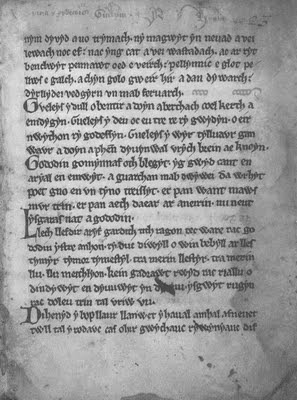
Oddly enough it is poetry, not historical documents, that shed some more light on these dark years. The British poets and bards Aneiren and Taliessen witnessed or heard about the great and traumatic moments of the late 6th century. To them it was real life, happening to them and those they knew. Taliessen lived circa 534 to 599 and wrote about Urien and Owain of Rheged. Much of what we know about the struggles between Bernicia and Rheged we read of in his poems. Aneirin was younger - possible a young man in 597 at the battle of Catreath and it was his poem about it – Y Goddodin that is really the only record of the event.
Modern References
There are many books that have been written that discuss events in he period 550 to 650 AD. It can be tempting to take them at face value and assume they are correct. However you soon discover that they often contradict each other and that many are making assumptions and simplifications themselves and that all struggle with the same paucity of original sources. So all must be taken with a pinch of salt. That said there are a few useful sources for someone researching this period:
The Mammoth Book of British Kings and Queens Mike Ashley takes all the material including a vast number of commentaries and modern books on the monarchies and nations of the last 2000 years and tries to set out a definitive record. It is the most accesible of the reference tools I used.
The Age of Arthur John Morris. Written by an academic whose area of expertise was the period 350 to 650 this tries to lay out as fact a coherent history for the period. It ha been widely criticised by historians for relying heavily on interpretation but at least Morris gives us A version of history. The problem with many academics work is there is almost NO attempt to sift the evidence and present an interpretation. Morris has the courage to do that.
An English Empire NJ Higham is a work that conducts an analysis of what Bede writting tells us about this period and is a useful commentary although abit limited to Bede’s perspectice.
The Britons Christopher Snyder is an academic work with a lot of archaeological references but is a good summary of current thinking on the period. He presents the arguments that are current (or where a few years ago) and tries to weigh them.
Making sense of it all
This then is the problem that writers of historical fiction set in the late 6th and early 7th century have. There is something like a 150 year gap in reliable data. There are theories and ideas but in the end you just have to examine it all, visit the possible battlefields and locations that are known about and make the best effort to create a believable world, to bring to life those that lived in these forgotten but critical years – the birth of England.

November 24, 2012
Excellent starting point for the art of Book Promotion
I am a self published author and – for the sake of transparency – I am one of the authors mentioned in this book.
WAIT – don’t just assume I have given it a good rating because of this fact. I received a review copy and read the book in 3 days and did so because it was very readable and very accessible and summarized in 150 pages the essence of good book promotion.
Debbie Young has spent a long time pulling together all the various aspects of book promotion that a self published author needs to look at. I started on my own self publishing journey in October 2009. I made a LOT of mistakes in my journey and as a result wasted a lot of time and money. Now – 3 years on I can honestly say I WISH this book was available then.
Any criticism or comments? Well IMHO I think the chapter at the end on editing, typesetting and cover design really belongs at the very beginning. I wasted a LOT of time and effort producing poor quality designs and because at the start I had no editor my product suffered. I now have an editor and a book design artist and have learnt quite a bit about typesetting. So READ chapter 12 FIRST and get all those ducks in a line before you proceed.
I would also have liked to see an advanced chapter for those of us doing all this stuff already
Having said all that I found that the book prompted me to look at areas where I was not active enough and in January when I sit down to work out my plan for 2013 I will refer to this book.
So if you are a starting out self published author read this book. It will tell you all you need to know to begin book promotion.
http://www.amazon.co.uk/Sell-Your-Books-Promotion-Self-published/dp/1906236348/ref=sr_1_1?ie=UTF8&qid=1353793784&sr=8-1

November 22, 2012
Recording Audiobooks – my setup
Two years ago I recorded The Amber Treasure and released it in episodes via Podiobooks.com. This is a US based site which will publish audio books. It also feeds them to Itunes again as podcast episodes.
Over a couple of years the book had 300+ downloads and some good feedback. As a first experiment in recording audiobooks it was not a bad way to go.
Recently I decided to move forward and look to record some of my other books and I am using http://www.helpforwriters.me/ whom I met at the New Writers UK Fair. (This annual event at Nottingham in November is a gathering of self published authors, associated folk such as editors and agents etc). I don’t find I sell many books there BUT as a place to network and make contacts it is useful. They are taking both The Amber Treasure and Child of Loki (which I am currently recording).
My “home studio” is very basic. It consists of
A)This PC
B)A free to download copy of Audactity 
Which is a recording and editing programme.
[image error]
C)A Shure FM 58 XLR microphone . This was recommended to me by several pod-casters as a very good sub £100 microphone (you DONT want to use a skype headset). To get the sound from the microphone INTO the PC you cant just plug it into a PC like a skype headset. You need to feed it through either a mixing desk OR a PRE-AMP. This is mine:
D)Shure X2U Pre Amp. The microphone plugs into the pre-amp and the pre-amp has a USB connection to the PC. The USB cabel powers the microphone. Te preamb has controls to adjust the gain/boost on the microphone and also to allow play back of the audio input (see later for an issue with this).
E)A microphone stand and boom. You don’t want to hold the microphone or put it on a desk which might pick up vibrations from the PC. I picked up a cheap £20 stand from a local music shop who also sold me the microphone.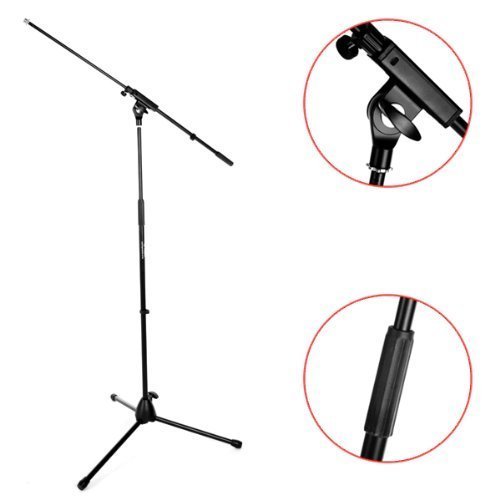
F) pop shield. This is a circular shield that sits between you and the microphone and stops the b’s and p’s “popping” so much. I bought one from Maplins and it works fine. The only issue is the clamp which hooks onto the stand is not very good and I ended up having to tape up the clip to keep it from coming loose.
G)A good set of headphones. ideally ones whcih fit all around your ears. Which a good set you can pick up all that extraneous noise.
How much did it all cost?
I will leave out the cost of the PC as I assume you have one already. The only thing to say about that is that a very low end one may not produce good quality results.
Microphone is about £100. Pre amp around £80 but you can pick up a bundle for around £165. The stand and pop shield should be about £25. Headset around £20 to £40.
So for less than £225 you have a home recording studio. Hook it all up and get recording.
Problems…problems
There are a couple of issues you have to overcome.
A)Background noise. I live under a flightpath and there is a trainline that goes past the sports club at the bottom of my garden. So when recording I have to check to make sure I don’t pick up on those noises. Even without them there are many extraneous noises that can creep onto a recording – the hum of a PC, the noise of your central heating, waterpipes etc etc. I have read of podcasters who record in wardrobes or under a blanket to to and muffle all that.
B)Breath sounds. You can try and angle the microphone to avoid picking up breath sounds but whatever you try you WILL find breath sounds reach the track. You just need to remove them in Audactity.
C)Hiss. Often sound equipment will have a hiss. YOU can try reducing the microphone gain. BUT HERE IS MY TOP TIP for the X2u pre-amp. I found that I was hearing a hiss coming through my headphone which was plugged directly into the X2u. It is good to do this to HEAR what the microphone hears BUT I found that the X2U was producing a hiss. This hiss was not really on any recording so the headset must be producing it. What I do is listen to play back from a headset plugged into my PC’s speakers.
D) Selling your audiobooks. When an author publishes a e-book her or she can upload to Amazon or Smashwords and start selling it. The same is NOT true with audiobooks at least NOT so here in the UK. You need a distributor who perhaps handles dozens of authors and with whom the audiobook retailers such as Amazon, Itunes and Audible are willing to talk. Alternatively you can just sell the audio books via your own website but one of these aggregators and distributors can give an author more exposure.
I have an ambition to soon record a dramatization of The Last Seal or Tomorrow’s Guardian with multiple voices. (My daughters drama group). For that I will need a mixing unit to combines the signals from multiple microphones.
So if you are self-published and have made the step and have your books also available as e-books BUT NOT audiobooks maybe it is time to explore this medium as a way to reach more readers …or should that be listeners?
November 13, 2012
The Next Big Thing
I’ve been tagged in The Next Big Thing by fellow writer Helen Hollick Website: www.helenhollick.net and main Blog: http://ofhistoryandkings.blogspot.com/ who writes historical fiction and pirate-based adventure. Helen reached the USA Today Bestseller list with her novel The Forever Queen in 2011.
I’m instructed by Helen to tell you all about my next book by answering these questions and then I tag four other authors about their Next Big Thing. So here I go!
What is the working title of your next book?
Princes in Exile
Where did the idea come from for the book?
Princes in Exile is the third book in my Northern Crown Series. This series is set in the early years of Anglo Saxon England around AD 600 and follows the story of a young boy growing up in these - the darkest years of the dark ages when the Kingdom of Northumbria would rise to power. The series started in the B.R.A.G medallion winning novel, The Amber Treasure. The third book takes up the story when Cerdic is now 23 and guiding a rag-tag band of refugees across a divided nation looking for allies and a plan for the future.
What genre does your book fall under?
Historical Fiction.
Which actors would you choose to play your characters in a movie rendition?
Chris Themsworth (Thor) would be great for huge tough Eduard, Tom Felton (Draco Malfoy) might do a good Hussa, whislt William Mosely (Peter in the Chronicles of Narnia ) might work for Cerdic himself.
What is the one-sentence synopsis of your book?
No land, no crown, no plan …
Will your book be self-published or represented by an agency?
Self published via my own independent publisher – Mercia Books
How long did it take you to write the first draft of your manuscript?
I am still writing it. I expect the answer will be about 6 months.
What other books would you compare this story to within your genre?
It is a similar style of books to the amazing Bernard Cornwell’s Alfred the Great series (although three hundred years earlier of course).
Who or What inspired you to write this book?
I have always found the Anglo-Saxon period fascinating but whilst the later period has its writers including Bernard Cornwell and Helen Hollick the early period does not have that many writers and many write from the point of view of the Welsh/ British not the English. These times are the birth pangs of the British nations as we know them today and I think there are a lot of stories about this time that should be retold.
What else about your book might pique the reader’s interest?
We look back from the vantage point of history and know that England came to exist, thrive and survive. But in AD 597 it was by no means certain that this would be the case. These are dangerous, chaotic, unpredictable times. Journey back with me to a point in history when the future is far from certain.
Here are some lovely authors I’ve tagged to tell you about their Next Big Thing! …..
Jane Brown author of the The Bitti Chai http://janegray.webs.com/thebittichai.htm
Michelle Gent horror/thriller writer http://www.dmichellegent.co.uk/blog.html
Claire Kinton author of The Dead Game http://www.clairekinton.com/blog.html
Mick Pearson (details coming)
My thanks to Helen Hollick for Tagging me
Facebook: www.facebook.com/helen.hollick
& Twitter: http://twitter.com/HelenHollick

The Mission of St Augustine to Anglo-Saxon England
by Richard Denning
Christianity had come to Britain in Roman times but following the Roman withdrawal in about 416 AD and the steady conquest of what would one day be England by the Anglo-Saxon immigrants it was confined mostly to the lands under the control of the Romano-British Welsh (increasingly confined to the west) , the Irish and the Scots. The vast bulk of the land under the rule of the Saxons was pagan.
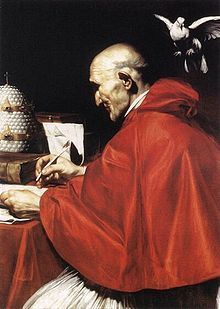
Pope Gregory I
The church in Rome was certainly aware of the reversal of its fortunes in the former province of Britannia. According to legend Pope Gregory I (Pope 590 to 604) once saw fair haired Anglo -Saxon boy slaves in the forum in Rome. He enquired who these were and was told they were Angles to which he poetically was said to reply Non Angli, sed Angeli. (“Not Angles, but Angels.”) and determined that this race should be converted to Christianity. When he became pope he set about just this task. But he needed a man for the job.
Augustine
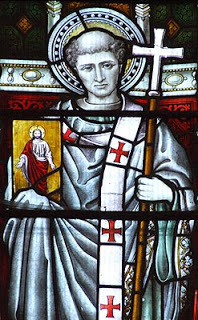
In the 580s Gregory had founded and been the Abbot of the Monastery of St Andrews on the Caelian Hill in Rome. One of his former monks had now risen to become Prior of St Andrews and it was to this man, Augustine and forty of his monks that Gregory now turned. Now in the year 595 Gregory asked Augustine to go to Britain and convert the English.
We know little about Augustine prior to his appointment. He was probably the son of a wealthy Roman but beyond that there is a scarcity of information. This is NOT St Augustine of Hippo who wrote many of the religious essays that shaped medieval Christianity but a totally different man.
The Mission
There is uncertainty over where the idea of this mission originated. The official version is as we have seen that it was the idea of the pope. There has been a suggestion that Gregory was approached by Bertha the queen of Kent. Bertha was the daughter of a king of the Franks and a Christian. Her husband, Aethelberht of Kent was pagan but tolerated his wife’s religion. Possibly Aethelberht saw political advantage in requesting ties with Rome.
In any event Kent was the logical choice for a mission. It’s ruler would not oppose their presence and moreover Kent’s alliance with Burgundy and the Franks would allow safe passage for Augustine especially after Gregory wrote to their rulers requesting assistance. Augustine’s route was laid out but after departing from Rome he and his party almost turned back in France. It needed another push from Gregory to finally get them to England in 597 AD.
Kent and it ruler was receptive to the message. Baptisms and the establishment of a monastery soon followed and Aethelburht himself converted after some months. In Canterbury at the same spot where an old Roman church stood (St Martins) the foundations were laid for what would one day be the cathedral that today is the senior cathedral of the church of England.
In 601 AD Gregory confirmed Augustine as Archbishop of Canterbury and sent more missionaries with instructions to appoint bishops, a plan to have an Archbishop at York (this would not occur for 25 more years) and also encouragement to spread out and incorporate other kingdoms under his authority.
What to do about Pagan Temples and Traditions?
As the Augustine mission expanded it was faced with the issue of the pre-existing pagan culture of the English and their temples and traditions. Should the Roman Christians ban the festivals and destroy the temples. The Pope sent instructions to Augustine on this matter via one of the new Abbots.
‘Tell Augustine that he should be no means destroy the temples of the gods but rather the idols within those temples. Let him, after he has purified them with holy water, place altars and relics of the saints in them. For, if those temples are well built, they should be converted from the worship of demons to the service of the true God. Thus, seeing that their places of worship are not destroyed, the people will banish error from their hearts and come to places familiar and dear to them in acknowledgement and worship of the true God. Further, since it has been their custom to slaughter oxen in sacrifice, they should receive some solemnity in exchange. Let them therefore, on the day of the dedication of their churches, or on the feast of the martyrs whose relics are preserved in them, build themselves huts around their one-time temples and celebrate the occasion with religious feasting. They will sacrifice and eat the animals not any more as an offering to the devil, but for the glory of God to whom, as the giver of all things, they will give thanks for having been satiated. Thus, if they are not deprived of all exterior joys, they will more easily taste the interior ones. For surely it is impossible to efface all at once everything from their strong minds, just as, when one wishes to reach the top of a mountain, he must climb by stages and step by step, not by leaps and bounds…. Mention this to our brother the bishop, that he may dispose of the matter as he sees fit according to the conditions of time and place.’
So the church was to be pragmatic. It would re-use pagan temples as the people were already used to worshipping in them. They would not ban pagan festivals but adapt them. Saints days and holy days would often fit in which pre-existing pagan dates and so rather than expect the people to lay aside their parties and festivals they would be taken over as time of joy and celebration.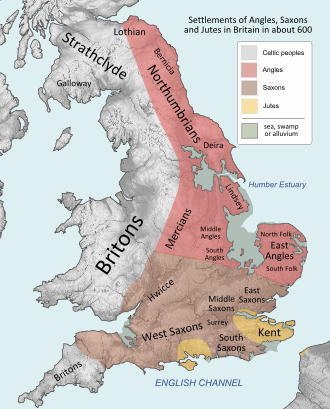
The Mission gets harder
Britain was not one nation. It was divided into Anglo-Saxon eastern kingdoms and Romano-British welsh western kingdoms as well as Irish, Picts and Scots. There were dozens of kingdoms and each of the Saxon lands were pagan. Some were receptive. Some very resistant. Some kingdoms would convert only to revert to paganism when a new king came along. Mercia would not become Christian until as late as the 8th century in parts. Never the less gradually Augustine was able to penetrate other lands and the Augustine mission was deemed a success.
That was until he came across the Welsh.
Meeting the Welsh
In around 603 Augustine requested a meeting with the Welsh bishops at a place known as Augustine’s oak – somewhere around the border of Mercia, Hwicee and the Welsh lands. From the start there was trouble. The Welsh bishops had maintained a Christian church in the land for 300 years. Forcefully separated from Rome by the English lands the church had evolved independently after Rome abandoned Britannia. This led to several differences. The method of appointing bishops, the timing of Easter, the approach to converting the pagan English and even the tonsure (the style of monks hair cut) was now different.
Augustine insisted that the Welsh abandon their traditions and conform to Rome’s teachings. His attitude was so arrogant that the meeting broke up.
A later meeting some months later was arranged. The Welsh bishops were uncertain how to approach it and sought advice from a wise man who suggested that they allow Augustine to arrive first and then go in. If he rose (as if greeting equals) then they should try and reach accommodation. In the event he did not rise and they realised then that he looked down on them and treated them as inferior. To Augustine’s mind HE was the Archbishop and these WERE inferior. The Welsh did not see it that way and left. It would take many years to reach accommodation after this failure.
The end of his mission
It is believed that Augustine died between 604 and 609 AD. In those brief few years he had re-established the Christian church in the land ruled by the English and set the foundation of the structure that would last until Henry VIII separated from Rome. Canterbury is still the seat of the Archbishop. So in that regard he was a success. His failings were arrogance as witnessed by his dealings with the Welsh. He is venerated as a saint in the Roman Catholic church and accepted as the father of the Church in England. Certainly his mission had a powerful effect on the evolving land that would one day become England.
The Augustine mission will feature in the third book of my Northern Crown series Princes in Exile

November 4, 2012
Self Publishing News
A few items of news relevant to self publishing authors arrived in my inbox this last few days so I thought I should share them.
Nook Opens in the UK
Barnes and Noble have made a move into the UK e-books market by launching http://uk.nook.com only last week – a site where UK readers can buy e-books for heir nook. At the same time the Nook is on sale in 2500 stores around the country. With Christmas fast approaching B&N are clearly making a bid for a piece of what will probably be the biggest digital Christmas with millions of Brits having Kindles, Nooks and Ipads for Xmas.
Apple ibooks move into fresh territories
At the same time Apple have opened up ibook stores in countries including Brazil, Mexico, Argentina, Bolivia, Chile, Colombia, Costa Rica, Dominican Republic, Ecuador, El Salvador, Guatemala, Honduras, Nicaragua, Panama, Paraguay, Peru, Venezuela, and New Zealand. This brings many millions of new readers into the market for ebooks.
The easiest way to distribute and sell books to these markets is probably via Smashwords – the US based e-book distributor which is ideal for self published authors to use. You just set up an account, read the very detailed formatting document and then upload your books. Smashwords take care of the distribution to Apple, Barnes and Noble, Sony etc. The only store they don’t yet distribute to is Amazon and to be honest you are best formatting your own kindle books and uploading to Amazon direct.
You can read more about Smashwords here: Converting Novels into Various e-book formats
You can read more about formatting for Kindle here: How to prepare a book for Kindle
I recently joined the Alliance of Independent Authors which is a group of authors in the US, UK and worldwide who share expertise and knowledge about the process of self publishing. Their website and blog is stuffed full of detailed articles and advice for authors and I would recommend checking them out as a treasure trove of useful information.
http://allianceindependentauthors.org/
Reading Agency and Alliance of Independent Authors pilot scheme in Libraries
One interesting initiative has been developed whereby self published authors are linked into libraries and readings groups. For a number of years traditional publishers and mainstream authors have been linked into Libraries via the Reading Agency scheme but a new partnership aims to involve self published authors.
More on that here: http://selfpublishingadvice.org/blog/wp-content/uploads/2012/11/alli-news-2012-novdec-final.pdf

November 2, 2012
Early Anglo Saxon Clothing
When the Anglo-Saxons Came to Britain what clothing did the wear? Objects found in graves as well as illustrations in Anglo-Saxon scrolls and books, stone engravings and images on objects can all give us a clue.
Male clothing included shirts made of wool or linen and some form of loin-cloths. On their legs they wore woolen trousers or sometimes leggings. Over this was worn a tunic to mid thigh or even reaching to the knees. It could be plain or have decorations around neckline and wrists.
A belt worn at the waist provided a practical location to hang a pouch, knife or seax and other accessories. Shoes were made usually from leather fastened with toggles and loops.
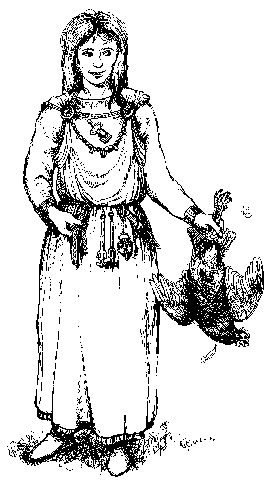 Women would wear a tubular dress fastened at the shoulders. In warm climates this would suffice but in Britain’s cooler climate often a tunic would be worn under the dress and/ or a cloak over the top:
Women would wear a tubular dress fastened at the shoulders. In warm climates this would suffice but in Britain’s cooler climate often a tunic would be worn under the dress and/ or a cloak over the top:
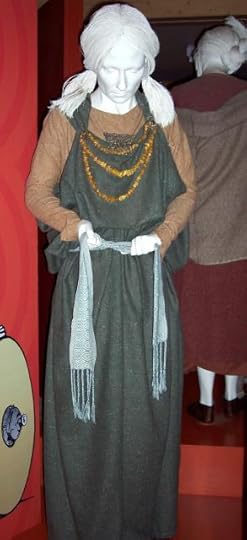 Women like men would usually have a belt, carry a small knife and pouch but also the senior female would carry keys to lock the store of food.
Women like men would usually have a belt, carry a small knife and pouch but also the senior female would carry keys to lock the store of food.
Anglo-Saxon children wore clothes similar to the adults. Boys: trousers with a tunic and a belt at the waist, like men. Girls: a tunic dress band maybe an over-dress held together with a pair of brooches at the shoulders.
Women and girls wore a lot of jewelry . The finds at Sutton Hoo and Stafford shire give us some idea of the splendor and variety of treasures that they wore.

October 28, 2012
About the Author on Amazon US and UK
Amazon have announced that their About the Author feature is now available for Amazon.co.uk as well as .com What is About the author?
Well put simply the information that an author has on their author page on Amazon will be available to owners of Kindle Fire and Kindle Paperwhites directly on their devices. So if they read an author’s book and want to know more about them including what other books are available, see your photo and biography they can do so. They can then buy those books.
Authors should make sure that they have updated their page via Author Central. This should include checking they are happy with their photo, making sure all book details are correct ( including that all your books are listed).
Author central can also take feeds from twitter and show videos (although these features wont show up in About the Author.). IN the US but NOT in the UK it can also take your blog feeds.
October 16, 2012
Shield Maiden wins Literary Classic International Book Award
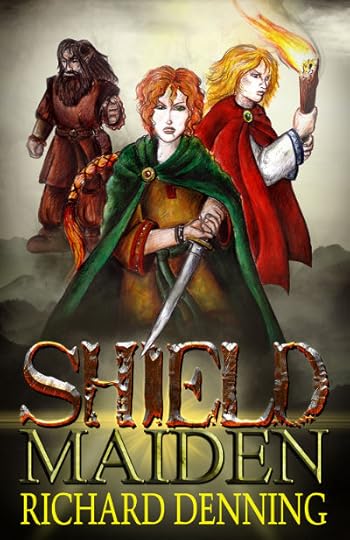 I am delighted to announce that Shield Maiden has won a Silver Award in the Literary Classic International Book Awards in the Pre Teen Fantasy section.
I am delighted to announce that Shield Maiden has won a Silver Award in the Literary Classic International Book Awards in the Pre Teen Fantasy section.
Here is the review that the same organisation did on Shield Maiden:
Shield Maiden, by author Richard Denning, is an exciting children’s chapter book which takes place in a Saxon village in 7th century Mercia. Denning’s characters come to life in this mythological adventure, the story of a 12 year old girl who finds a golden horn in the ruins of a Roman villa.
Shield Maiden, the first book in the Nine World’s Series, will hold great appeal for youngsters, regardless of their knowledge or understanding of Norse mythology; and kids interested in magic or fantasy are certain to appreciate the story of the Shield Maiden.
Brief explanations of some of the Norse mythological characters are included at the conclusion of the story, adding a greater understanding of some of the events which take place in this exciting story.
We recommend Shield Maiden for general reading, and as an educational tool to help youngsters gain insight and understanding into Nordic Mythology.
Shield Maiden earns the Literary Classics Seal of Approval.
Find out more here: http://www.richarddenning.co.uk/shieldmaiden.php
October 7, 2012
With the Worm at Kimberley
Yesterday I went up to the first Kimberley Book Worm Day. This was the idea of fellow NWUK member Gloria Morgan. It was the end of a summer of book related activities in this small town not far from Nottingham. These activities have included:
Shop front displays: shops were invited to put on displays connected to books with a prize given out to best two.
Book Worm Day: Local schools were invited to take part in a book worm parade., The response to this was mixed and I am delighted that the school which I had been linked to – Larkfields – was able to attend and put on a superb effort with great looking book characters and a brilliant pair of book worm. Others schools declined involvement or – worse in my opinion – agreed only to pull out at the last minute. I wished the other schools had shown more enthusiasm for an event organised by a local author but I guess schools get busy and asking teachers to get involved on a weekend is not popular. I hope that having seen the efforts of Larkfields that there would be more interest in 2013 if the event happened again. As part of this activity we authors were invited to visit the schools and give talks. IN my case it was about E-books. I hope to go back and visit again sometime.
The Infant School Book Worm
 The Junior School Book Worm/ caterpillar
The Junior School Book Worm/ caterpillar
Infant School as characters
The Great Kimberley Read. A number our fellow authors send in copies of their books and they have been in the Library on display all summer and being borrowed and read by the locals. These library users then voted on their favorite book.
The prize was given to Alan Dance for his book Leen Times.
Book Fair: We were invited to set up stalls with our books in an Old baptist Church. Some of the children and families did come in an look around. My father was on duty as Edward Dyson (from Tomorrow’s Guardian)
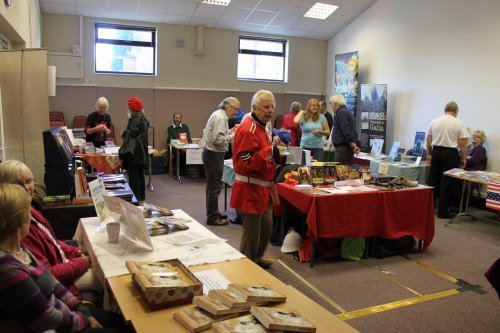 I was happy to be part of the event. As with all such ideas there is a LOT that might be done to build on the initial concept and make it bigger BUT it is important that such events occur. Well done Gloria.
I was happy to be part of the event. As with all such ideas there is a LOT that might be done to build on the initial concept and make it bigger BUT it is important that such events occur. Well done Gloria.




